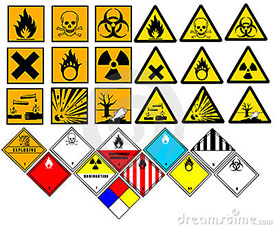Chemical Hazard
Chemical threat concerns are from the intentional or accidental release of a toxic gas, liquid or solid that can poison people and the environment. In certain situations, systems are in place to provide warnings to high-risk areas, however situations may arise when a chemical disaster takes place without warning.
These are some of the signs for a possible chemical threat:
- Numerous people suffering watery eyes, twitching, choking, having trouble breathing or losing coordination.
- Many sick or an unnatural amount of dead animals are also cause for suspicion.

Planning
In the event of any chemical disaster, it's important that you plan ahead. Stay current on possible threats in your community. And always keep emergency numbers on hand for medical emergencies related to chemical exposure. To learn more visit the EPA's website.
In certain situations, you may be required to shelter-in-place. If so, you should have a "Safe Area" designated in your home or business and it should be stocked with the following items:
- Portable Room Air Filter
- Duct tape
- Canned food and can opener
- At least three gallons of water per person
- Protective clothing, bedding, or sleeping bags
- Battery-powered radio, flashlight, and extra batteries
- Special items for infant, elderly, or disabled family members
Preparedness
Always be prepared to take action in the case of chemical exposure, following these important guidelines.
- Strip immediately and wash thoroughly.
- Look for a hose, fountain, or any source of water, and wash with soap if possible, being sure not to scrub the chemical into your skin.
- Seek emergency medical attention.
Response
If you see signs of chemical attack or chemical exposure, react promptly following these general rules.
- Quickly try to define the impacted area or where the chemical is coming from, if possible.
- Take immediate action to get away.
- If the chemical is inside a building where you are, get out of the building without passing through the contaminated area, if possible.
- If the contaminated area surrounds your present location, take appropriate steps to "shelter-in-place."
- If you are outside, quickly decide what is the fastest escape from the chemical threat. Quickly determine whether you can flee the contaminated area or if you should follow plans to shelter-in-place.
Homeland Security News - Shelter- in- Place